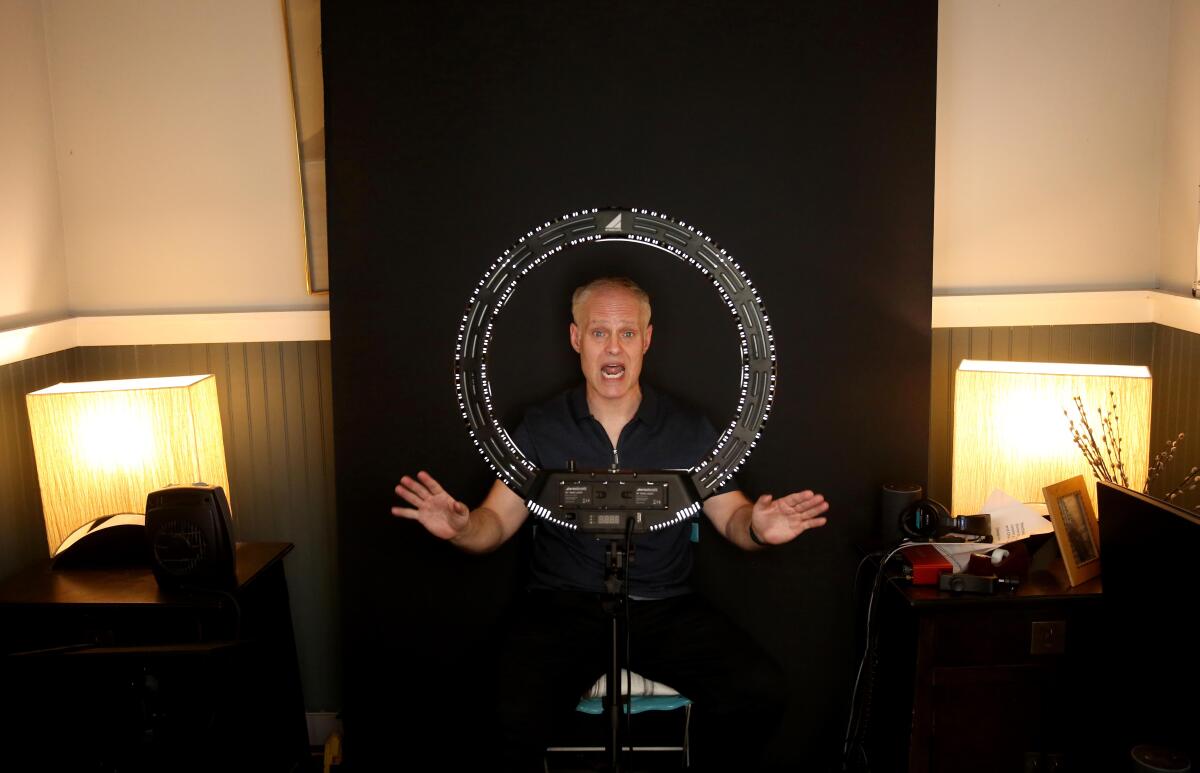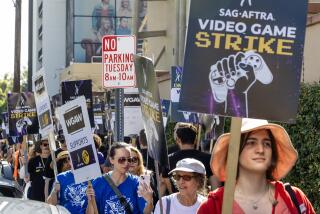5 things to know about a potential strike against video game companies

- Share via
SAG-AFTRA members will vote this month on whether to authorize union leaders to call a strike against video game companies.
The move, the latest sign of growing labor unrest in the entertainment industry, comes after the union’s film and TV actors went on strike in mid-July, joining Writers Guild of America-represented screenwriters who have been on the picket line since early May.
The union has been negotiating its video game contract, called the Interactive Media Agreement, for nearly a year.
SAG-AFTRA’s last contract with the video game companies, negotiated in 2017, did not address key issues like AI — a key concern in the current dual Hollywood strikes, where film and TV actors and writers worry about the technology encroaching on their jobs.
SAG-AFTRA said that it has held five separate, multiday bargaining sessions with an industry bargaining group consisting of signatory video game companies.
The game companies have failed to address members’ needs on issues of artificial intelligence, wages and safety, the union said. The contract expired last November.
More bargaining dates are scheduled for the end of the month. Both the negotiating committee and national board have said that the negotiating committee should have a strike authorization ready when bargaining resumes on Sept. 26.
“A successful strike authorization vote doesn’t initiate a strike,” the union said on its website. “Instead, the strike authorization permits the National Board to declare a strike if the video game companies fail to negotiate fairly with SAG-AFTRA for the benefit of its members.”
Who is covered under the interactive contract?
The interactive media agreement covers “off-camera [voiceover] performers, on-camera [motion capture, stunt] performers, stunt coordinators, singers, dancers, puppeteers, and background performers,” according to SAG-AFTRA.
What is the union asking for in its contract?
Some of the biggest sticking points in negotiations deal with the unregulated use of AI, an increase in wages and worker safety, union leaders have said.
To them, AI poses an equal or even greater threat to performers in the video game industry than it does in film and TV — particularly because many work in voice-over.
“The capacity to cheaply and easily create convincing digital replicas of performer voices is already here and widely available,” SAG-AFTRA said in a message posted on its website. “You can find the tools to do it yourself with a simple Google search. Without protections, not only will this be the future of how voices are recorded for video game characters, but your own voice recordings will be used to train the AI systems that replace you.”
Performance capture — in which professionals like stunt performers provide digitally captured performances for video game characters — could also be replicated through AI.
Society can’t stop AI technology from advancing, video game voice actors told The Times last month, but workers can secure contracts that would require their consent to reproduce their voice or likeness and compensate them when that does happen.
Workers are also asking for the same increase in wages sought in the film and TV contracts — a raise they said is key to keeping pace with inflation. The negotiating committee has asked for an 11% increase retroactive to the expiration of the last contract, as well as a 4% increase in the second and third years of the agreement.
On its website, SAG-AFTRA said that the employers’ wage proposal offered a 5% increase effective upon ratification, another 4% increase in the second year and a 3% increase in the third year. The signatory game companies made more than $19 billion in global revenue last year, according to union leadership.
The negotiating committee has also demanded greater worker protections. Those protections include a five-minutes-per-hour rest period for on-camera performers, the inclusion of a set medic for stunts and hazardous work, and a rule that would prohibit employers from asking performers to do stunts on self-taped auditions.
Postcards with instructions on how to vote online were mailed Sept. 5, the union said. Voting will close at 5 p.m. PT on Sept. 25.
What are game companies saying?
The industry bargaining group of signatory video game companies includes Activision Productions Inc; Blindlight LLC; Disney Character Voices Inc.; Electronic Arts Productions Inc.; Epic Games Inc.; Formosa Interactive LLC; Insomniac Games Inc.; Take 2 Productions Inc.; VoiceWorks Productions Inc.; and WB Games Inc.
Audrey Cooling, spokesperson for the video game producers who are party to the Interactive Media Agreement, said the companies “all want a fair contract.”
“We are negotiating in good faith and hope to reach a mutually beneficial deal as soon as possible,” Cooling said in an emailed statement to The Times earlier this month.
Have voice actors in gaming gone on strike before?
If those under the interactive contract go on strike, it would mark the first time they’ve done so since October 2016.
During that strike, SAG-AFTRA targeted 11 companies, including divisions of Activision Blizzard, Electronic Arts, Take 2, Insomniac Games, Warner Bros. and Disney.
The union had asked for a new compensation structure in those negotiations that would allow actors to receive residual-like payments based on a game’s commercial success. They also asked for improved safety conditions for voice-over and motion-capture performers.
But the video game companies balked at the union’s residual plan, instead proposing a 9% wage increase. They offered additional compensation of up to $950 per game based on the number of sessions a performer worked on a title.
The union and video game companies reached a tentative deal in September 2017 that included a new bonus compensation structure for actors who perform voice and motion-capture work in the game industry. The agreement was ratified in November 2017.
The video game strike, which lasted just over a year, marked the first major act of defiance from SAG-AFTRA following the merger of Hollywood’s two largest actors unions in 2012.
What about unions in other parts of the gaming industry?
A growing segment of the game industry’s workforce has also started to unionize in recent years, many of them quality assurance workers who have decried so-called “crunch” periods that lead up to a game’s release.
Game workers have also raised concerns over claims of discrimination, and called for fair and transparent pay.
Organizing efforts have hit studios acquired by gaming giant Activision Blizzard, as well as those under Microsoft, which is seeking to acquire the Santa Monica-based company.
A State of the Game Industry survey released in January found that a majority of game developers — 53% — are in favor of unionization. About one-fifth say they or their colleagues have actively discussed unionizing, according to the survey published by the Game Developers Conference and Game Developer, a trade publication.
Times staff writer Wendy Lee contributed to this report.
More to Read
Inside the business of entertainment
The Wide Shot brings you news, analysis and insights on everything from streaming wars to production — and what it all means for the future.
You may occasionally receive promotional content from the Los Angeles Times.










